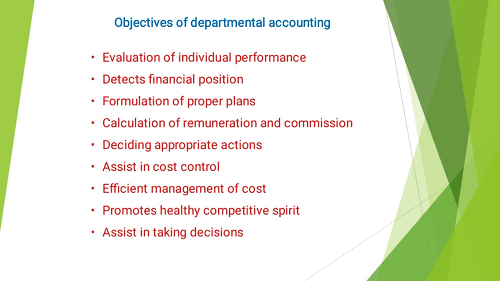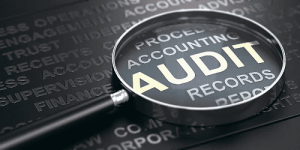Objectives of Departmental Accounting- The objectives of Departmental Accounting are:
- Performance Evaluation: To evaluate the performance of each department separately, by tracking revenues, expenses, and profits.
- Cost Control: To identify and control the costs incurred by each department, helping to pinpoint areas for cost reduction.
- Profitability Analysis: To ascertain the profitability of individual departments and allocate resources efficiently based on performance.
- Responsibility Accounting: To hold department heads accountable for the financial performance of their respective departments, motivating them to improve operational efficiency.
- Resource Allocation: To facilitate better decision-making regarding the allocation of resources, such as budget and manpower, among departments.
- Inter-departmental Comparisons: To enable comparisons between departments to foster healthy competition and enhance overall organizational efficiency.
- Financial Reporting: To improve the accuracy and transparency of financial reporting by providing detailed information on each department’s financial performance.
- Pricing Strategy: To assist in setting appropriate pricing strategies for products or services offered by individual departments.
- Budgeting and Forecasting: To support accurate budgeting and forecasting by providing a clear view of the revenue and expense trends in each department.
These objectives help businesses better manage and optimize the performance of various departments within the organization.
What is Required Objectives of Departmental Accounting
The required objectives of Departmental Accounting typically focus on the fundamental goals that guide its implementation and use within an organization. Here are the essential objectives:
- Segmentation of Financial Information: To organize and present financial data for each department separately, facilitating a clearer understanding of departmental operations.
- Enhanced Accountability: To establish clear accountability by assigning financial responsibilities to department managers, fostering a sense of ownership over departmental performance.
- Performance Measurement: To measure the efficiency and effectiveness of each department by comparing budgeted versus actual performance, enabling the identification of variances and areas for improvement.
- Cost Allocation: To accurately allocate indirect costs to departments, ensuring that each department bears its fair share of overhead expenses.
- Profitability Assessment: To evaluate the profitability of individual departments, helping management to identify which departments contribute most to overall profitability and which may need restructuring or support.
- Decision Support: To provide management with critical financial insights that aid in decision-making regarding resource allocation, departmental investments, and strategic planning.
- Budgeting and Planning: To facilitate departmental budgeting processes, allowing for more precise financial planning and control.
- Interdepartmental Comparisons: To enable comparative analysis among departments, fostering competition and sharing of best practices for improvement.
- Compliance and Reporting: To ensure compliance with internal policies and external regulations by providing accurate and comprehensive financial reports for each department.
- Resource Utilization: To improve the efficient use of resources by tracking departmental performance and aligning it with organizational goals.
These objectives ensure that departmental accounting contributes to better financial management, operational efficiency, and overall organizational success.
Who is Required Objectives of Departmental Accounting

The required objectives of Departmental Accounting involve various stakeholders within an organization. Here’s a breakdown of who needs these objectives and why:
- Management:
- Purpose: To evaluate the performance of each department, make informed decisions, and strategize for resource allocation and budget planning.
- Department Heads/Managers:
- Purpose: To take responsibility for the financial performance of their respective departments, leading to accountability and improved operational efficiency.
- Accountants/Finance Teams:
- Purpose: To ensure accurate recording and reporting of financial data for each department, facilitating proper financial analysis and compliance with accounting standards.
- Investors/Shareholders:
- Purpose: To assess the profitability and financial health of the organization as a whole, and to understand how each department contributes to the overall performance.
- Internal Auditors:
- Purpose: To evaluate the accuracy and reliability of departmental financial reports, ensuring compliance with internal policies and regulations.
- External Auditors:
- Purpose: To review the financial statements and verify the integrity of departmental accounting, ensuring that financial reporting is accurate and adheres to regulatory standards.
- Employees:
- Purpose: To understand how their department performs financially, fostering a culture of transparency and motivating them to contribute to departmental goals.
- Regulatory Authorities:
- Purpose: To ensure that organizations adhere to financial reporting standards and regulations, which can involve examining departmental financial data.
By addressing the objectives of departmental accounting, these stakeholders can achieve better financial oversight, accountability, and strategic decision-making within the organization.
When is Required Objectives of Departmental Accounting
The required objectives of Departmental Accounting become particularly relevant during specific times and circumstances within an organization. Here are key situations when these objectives are crucial:
- Budgeting Periods:
- When: Annually or quarterly during budget preparation.
- Purpose: To set financial targets and allocate resources effectively for each department.
- Performance Reviews:
- When: During periodic evaluations (monthly, quarterly, or annually).
- Purpose: To assess departmental performance against budgets and prior periods, helping to identify variances and areas for improvement.
- Financial Reporting:
- When: At the end of financial periods (monthly, quarterly, annually).
- Purpose: To prepare financial statements that reflect the performance of individual departments for stakeholders.
- Cost Control Initiatives:
- When: When there are rising costs or inefficiencies.
- Purpose: To analyze departmental costs, identify inefficiencies, and implement cost-saving measures.
- Strategic Planning Sessions:
- When: During annual or biannual strategic planning.
- Purpose: To make informed decisions about resource allocation, departmental restructuring, or new initiatives based on financial insights.
- Compliance Audits:
- When: During internal or external audits.
- Purpose: To ensure that departmental financial practices adhere to regulations and internal policies.
- Operational Changes:
- When: During mergers, acquisitions, or significant organizational changes.
- Purpose: To assess how changes impact departmental financial performance and resource allocation.
- Investment Decisions:
- When: When considering new projects or capital investments.
- Purpose: To evaluate the financial viability and expected returns from departmental investments.
- Management Training and Development:
- When: During the onboarding or training of department heads.
- Purpose: To instill an understanding of financial accountability and performance measurement in department managers.
By focusing on these objectives at the appropriate times, organizations can enhance financial management, operational efficiency, and strategic decision-making across departments.
Where is Required Objectives of Departmental Accounting

The required objectives of Departmental Accounting can be applied across various settings within an organization. Here are the key areas where these objectives are relevant:
- Corporate Headquarters:
- Context: Centralized financial management and strategic planning occur here, making it crucial to evaluate departmental performance and resource allocation.
- Departmental Offices:
- Context: Individual departments (e.g., sales, marketing, production, finance) utilize departmental accounting to track their performance, costs, and profitability.
- Financial Departments:
- Context: Finance and accounting teams rely on departmental accounting to prepare consolidated financial statements, budgets, and reports that provide insights into each department’s financial status.
- Management Meetings:
- Context: During management discussions and strategic planning sessions, departmental performance metrics are reviewed to make informed decisions about the organization’s direction.
- Boardrooms:
- Context: When presenting financial reports to the board of directors, departmental accounting data is essential for understanding departmental contributions to overall corporate performance.
- Auditing Departments:
- Context: Internal and external auditors examine departmental accounts to ensure compliance with accounting standards and regulations.
- Training and Development Programs:
- Context: During training sessions for department heads and managers, understanding departmental accounting helps them grasp financial accountability and performance measurement.
- Budgeting and Forecasting Sessions:
- Context: These sessions often take place at various levels within the organization, where departmental accounting data informs budgetary decisions and financial forecasts.
- Regulatory Compliance Offices:
- Context: Departments responsible for ensuring adherence to financial regulations use departmental accounting to demonstrate compliance through accurate reporting.
- IT and Financial Systems:
- Context: Software systems used for financial management integrate departmental accounting, allowing for real-time tracking and reporting of departmental performance.
By implementing these objectives in these various contexts, organizations can enhance financial transparency, accountability, and strategic decision-making across all levels and departments.
How is Required Objectives of Departmental Accounting
The required objectives of Departmental Accounting are achieved through specific processes, methodologies, and tools. Here’s how these objectives are realized within an organization:
- Establishing a Clear Framework:
- Develop a departmental accounting framework that outlines how financial information will be segmented and reported for each department.
- Implementing Accounting Software:
- Utilize accounting software that allows for departmental tracking and reporting, making it easier to manage and analyze financial data across departments.
- Setting Performance Metrics:
- Define key performance indicators (KPIs) for each department, such as revenue, costs, profit margins, and return on investment (ROI), to measure and evaluate performance.
- Regular Financial Reporting:
- Prepare regular financial statements (monthly, quarterly, annually) for each department to provide insights into their financial performance and facilitate informed decision-making.
- Budget Preparation and Control:
- Create departmental budgets that align with organizational goals, and implement budgetary controls to monitor spending against these budgets.
- Cost Allocation Methods:
- Apply appropriate cost allocation methods (e.g., activity-based costing) to distribute indirect costs accurately among departments, ensuring a fair representation of each department’s expenses.
- Variance Analysis:
- Conduct variance analysis to compare actual performance against budgeted figures, helping to identify discrepancies and take corrective actions as necessary.
- Internal Controls:
- Establish internal controls to ensure accuracy and integrity in departmental financial reporting, which includes regular audits and reviews.
- Training and Development:
- Provide training for department managers and staff on departmental accounting principles and practices, ensuring they understand their financial responsibilities.
- Regular Performance Reviews:
- Hold regular performance review meetings with department heads to discuss financial reports, evaluate performance against objectives, and strategize for improvement.
- Stakeholder Communication:
- Communicate departmental financial performance and insights to stakeholders (management, board of directors, investors) to foster transparency and informed decision-making.
- Integration with Strategic Planning:
- Align departmental objectives with overall organizational strategy, using departmental accounting data to inform strategic decisions and long-term planning.
By implementing these methods, organizations can effectively achieve the objectives of departmental accounting, enhancing financial management, accountability, and overall operational efficiency.
Case Study on Objectives of Departmental Accounting
Objectives of Departmental Accounting in a Manufacturing Company
Background
XYZ Manufacturing Co. is a mid-sized manufacturing firm that produces various consumer goods. The company operates through multiple departments, including Production, Sales, Marketing, and Finance. As the business expanded, management recognized the need for a structured approach to financial management across departments to enhance accountability, performance evaluation, and decision-making.
Objectives of Departmental Accounting
- Performance Evaluation
- Implementation: XYZ Manufacturing Co. established key performance indicators (KPIs) for each department, such as production efficiency for the Production Department and sales growth for the Sales Department.
- Outcome: This allowed the management to assess how well each department was performing against its targets and to identify areas needing improvement.
- Cost Control
- Implementation: The Finance Department introduced a cost allocation system to track both direct and indirect costs associated with each department, using activity-based costing.
- Outcome: The Production Department identified excessive waste in the manufacturing process and implemented lean practices, resulting in a 15% reduction in costs.
- Profitability Analysis
- Implementation: The company segmented its income statements by department, allowing for detailed analysis of revenues and expenses.
- Outcome: The analysis revealed that the Marketing Department’s campaigns were driving sales, but the costs were significantly higher than expected. This prompted a review of marketing strategies.
- Responsibility Accounting
- Implementation: Each department manager was held accountable for their financial performance, with regular meetings to discuss budget adherence and financial results.
- Outcome: Department heads took ownership of their financial results, leading to improved budget management and more prudent spending decisions.
- Resource Allocation
- Implementation: Management utilized departmental financial data to make informed decisions about resource allocation for the upcoming fiscal year, prioritizing departments that showed higher profitability.
- Outcome: Resources were allocated more effectively, leading to increased overall company performance.
- Inter-departmental Comparisons
- Implementation: Monthly financial reports were shared across departments, allowing for benchmarking against each other.
- Outcome: This encouraged healthy competition and collaboration, with departments sharing best practices and strategies for improvement.
- Financial Reporting
- Implementation: Regular financial statements and reports were prepared for each department and presented to senior management and the board.
- Outcome: Improved transparency and understanding of each department’s financial health, facilitating better strategic decision-making at the executive level.
Conclusion
By implementing departmental accounting, XYZ Manufacturing Co. achieved significant improvements in financial oversight, accountability, and operational efficiency. The structured approach allowed management to make informed decisions, leading to enhanced performance across all departments. The company successfully navigated challenges and capitalized on opportunities, demonstrating the critical role of departmental accounting in organizational success.
Key Takeaways
- Establishing clear performance metrics is essential for accountability.
- Effective cost control and allocation can lead to significant savings.
- Regular financial reporting fosters transparency and informed decision-making.
- Inter-departmental comparisons encourage competition and continuous improvement.
This case study illustrates how the objectives of departmental accounting can be practically applied to achieve organizational goals and improve financial management.
White paper on Objectives of Departmental Accounting

Executive Summary
Departmental accounting is a vital tool for organizations aiming to enhance financial management, operational efficiency, and accountability across different segments of their business. This white paper outlines the key objectives of departmental accounting, illustrating how these objectives contribute to informed decision-making, performance evaluation, and overall organizational success.
Introduction
As businesses grow and diversify, the complexity of their financial operations increases. Departmental accounting provides a structured approach to managing financial information by segmenting data according to different departments. This method not only aids in tracking the performance of each department but also enhances strategic planning and resource allocation.
Objectives of Departmental Accounting
1. Performance Evaluation
Objective: To assess the effectiveness and efficiency of each department in achieving its financial and operational goals.
Implementation:
- Establish key performance indicators (KPIs) tailored to each department.
- Conduct regular performance reviews against these KPIs.
Benefits:
- Facilitates identification of high-performing departments and those needing improvement.
- Empowers management to make data-driven decisions regarding performance enhancements.
2. Cost Control
Objective: To monitor and manage costs effectively within each department.
Implementation:
- Implement a cost allocation system to track both direct and indirect costs associated with departmental operations.
- Regularly review departmental budgets and expenditures.
Benefits:
- Identifies areas of excessive spending and inefficiencies.
- Supports the implementation of cost-saving measures, such as lean management practices.
3. Profitability Analysis
Objective: To analyze the profitability of individual departments.
Implementation:
- Segment financial statements by department to provide a clear view of revenues and expenses.
- Conduct profitability analyses to determine contribution margins for each department.
Benefits:
- Enables management to identify which departments contribute most to overall profitability.
- Supports informed decisions regarding resource allocation and investment in high-performing areas.
4. Responsibility Accounting
Objective: To assign financial accountability to department managers.
Implementation:
- Create a framework for holding department heads accountable for their financial performance.
- Conduct regular meetings to review financial results and adherence to budgets.
Benefits:
- Fosters a sense of ownership and accountability among department heads.
- Encourages prudent spending and strategic decision-making at the departmental level.
5. Resource Allocation
Objective: To optimize the allocation of resources across departments.
Implementation:
- Use departmental financial data to inform resource allocation decisions.
- Prioritize departments that demonstrate higher profitability and growth potential.
Benefits:
- Ensures resources are allocated effectively to drive overall business growth.
- Enhances operational efficiency by supporting departments that align with strategic goals.
6. Inter-departmental Comparisons
Objective: To facilitate benchmarking and performance comparisons among departments.
Implementation:
- Share financial reports across departments on a regular basis.
- Encourage departments to share best practices and strategies for improvement.
Benefits:
- Promotes healthy competition and collaboration between departments.
- Identifies best practices that can be adopted across the organization.
7. Financial Reporting
Objective: To provide clear and accurate financial reports for each department.
Implementation:
- Prepare regular financial statements for each department and present them to senior management.
- Ensure compliance with accounting standards and regulations in departmental reporting.
Benefits:
- Enhances transparency and trust in financial reporting.
- Provides critical insights for strategic planning and decision-making.
Conclusion
The objectives of departmental accounting are crucial for organizations seeking to improve financial management, accountability, and operational efficiency. By implementing a structured departmental accounting framework, businesses can enhance their performance evaluation processes, control costs, analyze profitability, and make informed strategic decisions. The insights gained through departmental accounting not only empower management but also contribute to the long-term success of the organization.
Recommendations
To maximize the benefits of departmental accounting, organizations should consider the following recommendations:
- Invest in Technology: Utilize accounting software that supports departmental tracking and reporting.
- Train Staff: Provide training for department managers on departmental accounting principles and practices.
- Establish Clear Policies: Develop clear policies and procedures for departmental financial management.
- Review and Adjust: Regularly review departmental accounting practices and make adjustments based on organizational needs and market changes.
By prioritizing these recommendations, organizations can effectively leverage departmental accounting to achieve their financial and operational objectives.
Industrial Application of Objectives of Departmental Accounting
Departmental accounting plays a vital role across various industries by facilitating detailed financial management and enhancing operational efficiency. Below are specific industrial applications of the objectives of departmental accounting, demonstrating how these objectives contribute to improved performance, cost control, and strategic decision-making.
1. Manufacturing Industry
Objective: Cost Control and Profitability Analysis
- Application: In a manufacturing environment, departmental accounting helps in tracking the costs associated with production, quality control, and inventory management.
- Example: A company may implement activity-based costing to allocate overhead costs accurately to specific products or departments. This enables the identification of unprofitable products, leading to decisions on product discontinuation or redesign.
Outcome: By analyzing production costs and profitability, manufacturers can optimize production processes, reduce waste, and enhance overall efficiency.
2. Retail Industry
Objective: Performance Evaluation and Resource Allocation
- Application: Retail businesses often operate multiple departments such as sales, marketing, and inventory management. Departmental accounting allows for performance tracking of each store or department.
- Example: A retail chain may analyze sales data by department to assess the effectiveness of marketing campaigns and seasonal promotions.
Outcome: Insights gained from departmental performance evaluation can guide inventory purchases, staffing decisions, and promotional strategies, ultimately increasing sales and customer satisfaction.
3. Healthcare Industry
Objective: Responsibility Accounting and Cost Control
- Application: In healthcare, departmental accounting is crucial for tracking the financial performance of various departments, such as emergency, surgery, and outpatient services.
- Example: A hospital may implement departmental accounting to monitor costs related to patient care, staffing, and equipment usage in different units.
Outcome: This approach enables healthcare providers to identify cost-saving opportunities, improve resource allocation, and enhance patient care efficiency.
4. Construction Industry
Objective: Financial Reporting and Performance Evaluation
- Application: Construction firms manage multiple projects simultaneously, each with its own budget and timeline. Departmental accounting assists in tracking the financial status of each project and department.
- Example: A construction company can analyze the costs and revenues associated with different projects, evaluating which are most profitable and identifying delays or overruns.
Outcome: This allows project managers to make informed decisions about resource allocation, project prioritization, and bidding on future contracts.
5. Hospitality Industry
Objective: Inter-departmental Comparisons and Resource Allocation
- Application: Hotels and restaurants typically have various departments (front desk, housekeeping, food and beverage) that require individual performance assessments.
- Example: A hotel might use departmental accounting to compare the profitability of its restaurant and bar services, assessing which generates more revenue relative to costs.
Outcome: Such analysis can inform decisions on staffing, pricing strategies, and promotional efforts to enhance overall guest experience and profitability.
6. Information Technology (IT) Industry
Objective: Cost Control and Responsibility Accounting
- Application: IT companies often have different departments focused on software development, IT support, and project management. Departmental accounting helps track costs associated with each area.
- Example: A software firm might analyze the costs associated with different development teams to assess productivity and profitability.
Outcome: This enables management to allocate resources more effectively, incentivize high-performing teams, and optimize project costs.
7. Transportation and Logistics
Objective: Financial Reporting and Performance Evaluation
- Application: Transportation companies manage various departments, including logistics, customer service, and fleet management. Departmental accounting provides insights into each segment’s financial performance.
- Example: A logistics company may track the costs associated with each delivery route to identify inefficiencies or profitable routes.
Outcome: This helps optimize delivery operations, reduce transportation costs, and enhance service quality.
Conclusion
The objectives of departmental accounting are applicable across various industries, enabling organizations to improve financial management, accountability, and operational efficiency. By implementing departmental accounting practices, businesses can better control costs, evaluate performance, analyze profitability, and allocate resources strategically, leading to enhanced overall performance and competitiveness.
- Audit
- Budget
- Cost
- Forensic
- Financial
- Fund
- Governmental
- Management
- Social
- Tax
- Accounting period
- Accrual
- Constant purchasing power
- Economic entity
- Fair value
- Going concern
- Historical cost
- Matching principle
- Materiality
- Revenue recognition
- Unit of account
- Assets
- Cash
- Cost of goods sold
- Depreciation / Amortization (business)
- Equity
- Expenses
- Goodwill
- Liabilities
- Profit
- Revenue
- Generally-accepted principles
- Generally-accepted auditing standards
- Convergence
- International Financial Reporting Standards
- International Standards on Auditing
- Management Accounting Principles
- Annual report
- Balance sheet
- Cash-flow
- Equity
- Income
- Management discussion
- Notes to the financial statements
- Bank reconciliation
- Debits and credits
- Double-entry system
- FIFO and LIFO
- Journal
- Ledger / General ledger
- Trial balance
- Financial
- Internal
- Firms
- Report
- Sarbanes–Oxley Act
- Accountants
- Accounting organizations
- Luca Pacioli
- History
- Research
- Positive accounting
- Sarbanes–Oxley Act
- Creative
- Earnings management
- Error account
- Hollywood
- Off-balance-sheet
- Two sets of books
- Business analysis
- Business ethics
- Business plan
- Business judgment rule
- Consumer behaviour
- Business operations
- International business
- Business model
- International trade Trade route
- Business process
- Business statistics
- Debits and credits
- Revenue
- Cost of goods sold
- Operating expense
- Capital expenditure
- Depreciation
- Gross income
- Net income
- Income statement
- Balance sheet
- Statement of changes in equity
- Cash flow statement
- Financial accounting
- Cost accounting
- Management accounting
- Forensic accounting
- Fund accounting
- Governmental accounting
- Social accounting
- Tax accounting
- Architecture
- Behavior
- Communication
- Culture
- Conflict
- Development
- Engineering
- Hierarchy
- Patterns
- Space
- Structure
- Asset
- Brand
- Business intelligence
- Business development
- Capacity
- Capability
- Change innovation
- Commercial Marketing
- Communications
- Configuration
- Conflict
- Content
- Customer relationship
- Distributed
- Earned value
- Electronic business
- Enterprise resource planning management information system
- Financial
- Human resource development
- Incident
- Knowledge
- Legal
- Materials
- Network administrator
- Office
- Operations services
- Performance
- Power
- Process
- Product life-cycle
- Product
- Project
- Property
- Quality
- Records
- Resource
- Risk crisis
- Sales
- Security





